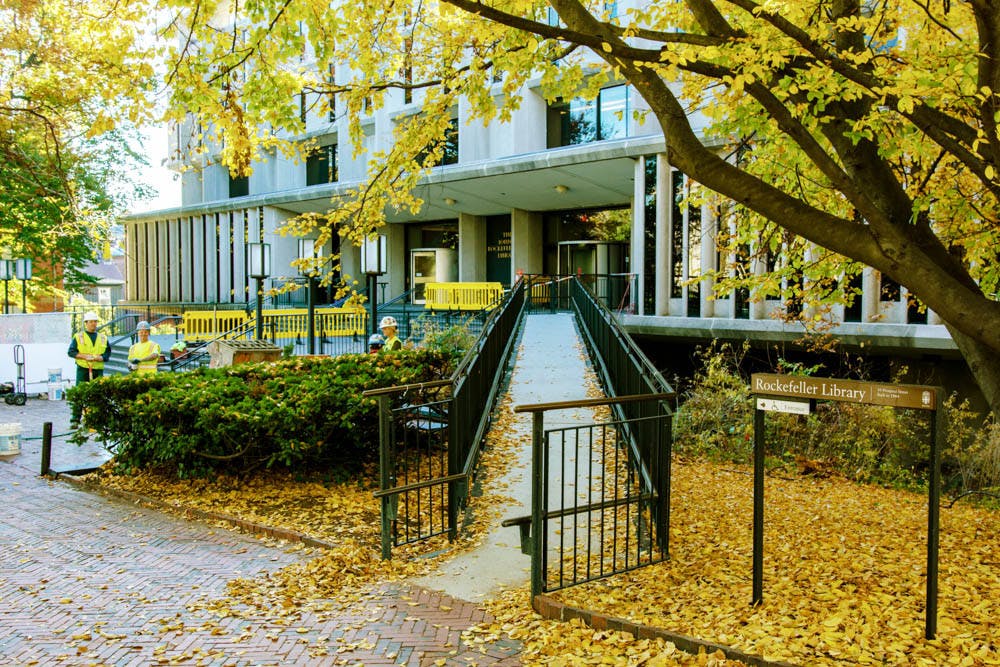Students ringing in Halloween were hit with an unwelcome surprise on Oct. 29 and 30 — a heavy downpour and powerful gusts of wind.
The only people more unhappy with the rain than students walking back from Hanleys were those devoted to a beech tree outside of the Rockefeller Library.
At the Rock, a branch from the beech tree crashed into University Librarian Harriette Hemmasi’s office window, though she was not inside at the time. Facilities removed the tree shortly after, Morin said, which saddened members of the community.
“This was a tree that was a friend year-round,” Hemmasi said. “It wore different clothes during each of the seasons, and I miss it terribly. And it would take probably 50 to 100 years to grow another such friend.”
When the Rock was constructed in 1964, students protested to ensure that the library would not harm the tree, Boylan said. Sam Miller-Smith ’18 said he wishes the tree’s removal had been a collective decision.
“Almost anyone would agree that the death of a tree that age is tragic,” Miller-Smith said. “Even if it may have been justified to cut it down in this context, that’s a question I hoped would be addressed by the Brown community at large.”
Miller-Smith estimated the tree measured around four feet in diameter. Under the City of Providence’s zoning ordinance, that would make it a “significant tree” — which requires approval from the City Forester to be removed.
The storm took other trees on campus, including those along Manning walkway near the Center for Information Technology, Keeney Quadrangle, Simmons Quad and Wriston Quad, among others, Armas wrote.
In addition to the damage caused by trees, 130,000 businesses and residences in Rhode Island lost power, and it cost the University $40,000 in damages, wrote Director of Environmental Health and Safety Stephen Morin in an email to The Herald.
“Custodial and Maintenance staff responded and have taken appropriate actions,” wrote Assistant Vice President Facilities Operations Paul Armas in an email to The Herald. “These costs are anticipated to be absorbed by the Facilities Management Department.”
The University also faced power outages in buildings off of main campus, including 10 Park Lane, the Marston Boat House, Tockwotton Studio and the Haffenreffer properties in Bristol, Morin wrote. University buildings on the main campus kept their power thanks to the University’s campus power distribution, which operates underground.
The University also received reports detailing water intrusion issues, Morin wrote.
The University’s response to the weather-related damage comes from its Emergency Action Plan, which was developed in 2001 as an “all hazards plan that provides response and preparedness information,” Morin wrote. In case of a weather emergency, students should monitor local radio and television stations, as detailed by the Emergency Action Plan. The plan also dictates that if the weather intensifies, the Shelter-in-Place command may be applicable. The Emergency Action Plan works alongside the Hurricane Plan to provide planning information and procedures for weather-related incidents.
The Hurricane Plan outlines processes that include ensuring all essential vehicles are “fully fueled, stocked and inspected” and encourages all students, faculty and staff to have a “Family Action Plan” in place outlining individual protocol before a storm strikes, Morin wrote. The plan also requires Brown Public Safety, Facilities Management, Dining Services and others to have current telephone numbers for emergency responders.
In last week’s storm, Dining Services operated normally “while being aware of conditions and ready to implement their contingencies as needed,” Morin said.





